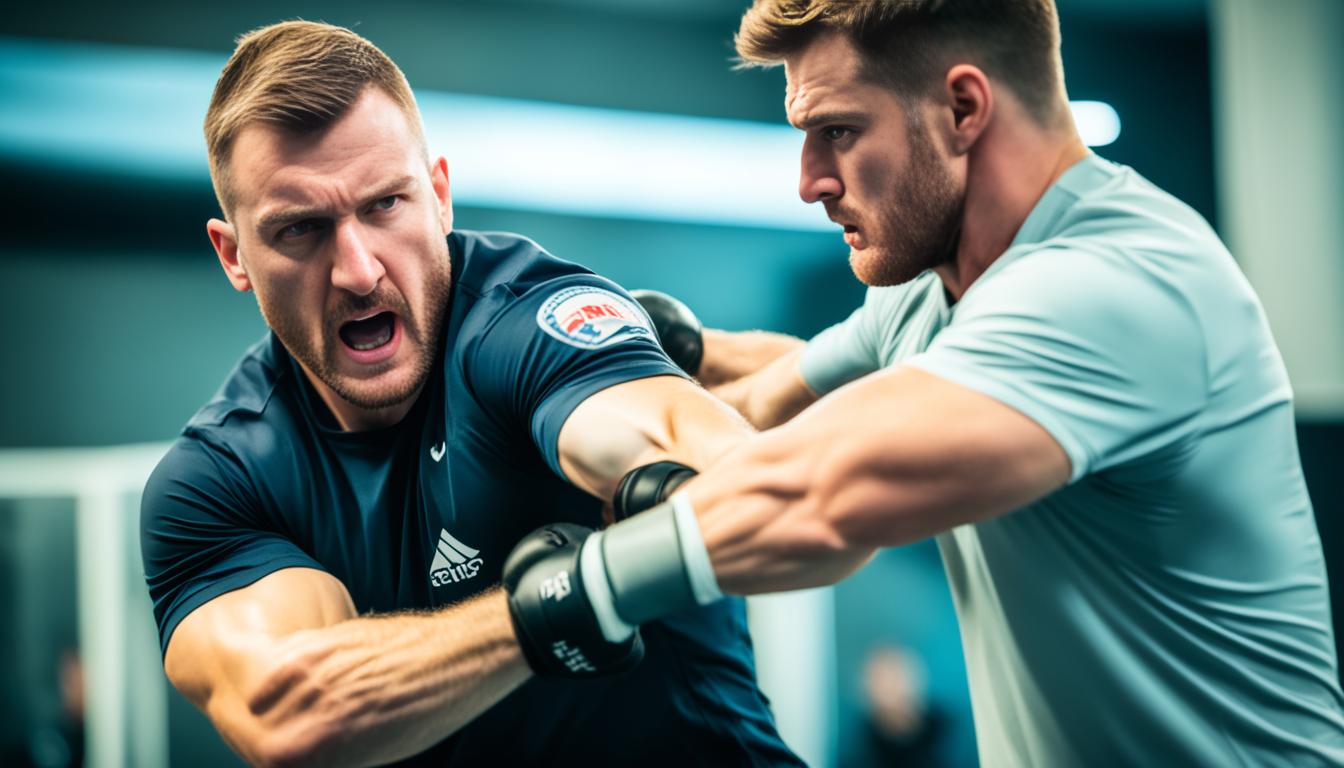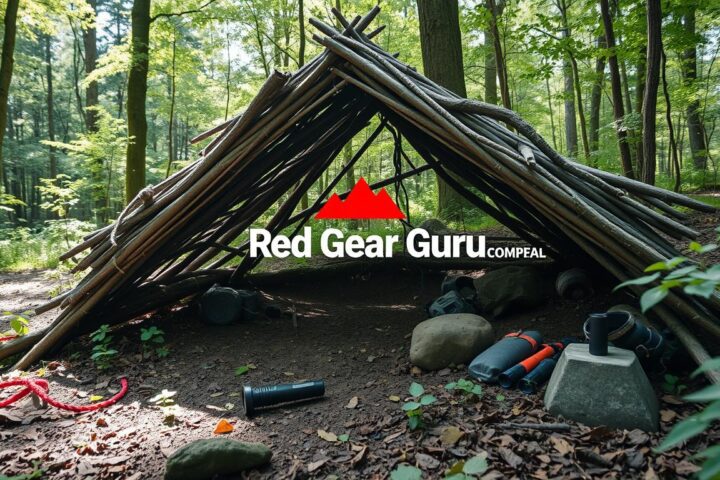Did you know one in three women will face a violent attack at some point? Women often deal with more verbal and sexual harassment than men. It’s vital for women to know how to defend themselves in dangerous situations.
Survival self-defense isn’t just about being strong. It’s about understanding attackers, spotting danger signs, and using moves to avoid fights. These basic moves can help you stay safe while walking, at parties, or just living your life.
Key Takeaways
- Survival self-defense strategies are key for staying safe, especially for women who face more violence.
- Knowing what attackers think and spotting danger signs are key to defending yourself.
- Learning moves like strikes, blocks, and dodges can help you protect yourself in stressful situations.
- Being aware of your surroundings and standing up confidently can make you less likely to be targeted.
- Self-defense training boosts confidence and gives you the skills to handle dangerous situations.
Trust Your Instincts: The First Line of Defense
Our instincts are key to staying safe. Studies show that attackers often pick on those who seem weak. So, being alert and aware is crucial to avoid danger.
Recognize the Warning Signs of Danger
It’s important to be sharp and notice your surroundings. Watch for signs of trouble, like predatory behavior. If something feels off, trust your instincts and get out fast.
Don’t Ignore Your Gut Feeling
Your gut is your first defense against danger. We often ignore that warning voice, but it’s right. Trust your gut about people, places, or situations. It acts faster than your brain to protect you.
Work on your instinctual awareness and intuitive danger detection. This way, you can spot threats early and protect yourself. Always listen to your gut; it’s there to keep you safe.
Present Yourself with Confidence and Awareness
Showing confident body language and staying alert can really help in self-defense. Criminals can spot a potential target in under seven seconds. They look for signs of weakness in how you walk, move your feet, and stand.
Walking with confidence, keeping your head up and shoulders back, makes you less likely to be picked as a target. Your body language shows if you’re ready to defend yourself. Walking confidently tells attackers you’re not an easy target to pick on.
- Maintain a strong, assertive posture to deter potential attackers.
- Utilize split-second glances to signal to potential threats that you are aware and not an easy target.
- Trust your gut instincts, as they can provide valuable feedback in potentially dangerous situations.
- Employ situational awareness to help prevent dangerous situations by anticipating and reacting to potential risks.
By being confident and alert, you can lower the chance of becoming a target. This lets you feel safer and more in control as you go about your day.
Establish Boundaries: Verbal and Physical
Protecting your personal space and setting clear boundaries is key to self-defense. Learning to use assertive body language and communicate clearly can help you handle dangerous situations with confidence.
Use Assertive Body Language
Your body language can send a strong message to others. Stand tall, make eye contact, and show confidence. This tells others you’re aware of your surroundings and won’t be an easy target.
Say “No” Firmly and Clearly
Saying “no” can be a strong way to protect yourself. If someone invades your space or makes you uncomfortable, say “no” clearly and firmly. This shows you’re ready to defend your personal space and freedom.
Remember, verbal self-defense and assertive communication are important for staying safe. By protecting your personal space and setting clear boundaries, you can lower the risk of trouble and empower yourself to stay safe.
Studies show that women who learn self-defense feel more confident and safe. They also get better at handling tough situations. Adding these skills to your life can be a big step in feeling more in control.
Maintain a Safe Distance and Protect Your Personal Space
Keeping a safe distance and knowing your personal space is key to survival self-defense. Everyone has a comfort zone that is their personal space. When someone enters this zone, you feel uneasy. This is because you know you might need to fight back if things escalate.
The distance you should keep from a threat depends on the time, place, and how you feel. Generally, try to stay about one to one-and-a-half arm lengths away from someone who might be a threat. If they get too close, speak up to protect your space. If they ignore your warnings, you might need to defend yourself physically.
Being far away is your best defense. If someone wants to hurt you, they must first get close to you, and the closer they get, the fewer options you have. Always be aware of your surroundings and be ready to act if needed.
- Keep a safe distance from threats, at least 20 feet in open areas like parks.
- If a threat is armed, stay out of their weapon’s range.
- Be alert for signs someone is getting too close, like a quick approach or getting closer slowly.
If you’re too close to a threat, you might need to run, call for help, or use a self-defense tool. Keeping your distance and protecting your space can stop an attacker before they act.
Survival Self-Defense Strategies: Basic Moves to Know
In the world of survival self-defense strategies, learning a few key moves is crucial. Whether you’re facing a street fight or an unexpected combat situation, knowing how to defend yourself can save your life.
One effective skill is the palm-heel strike. This move targets the attacker’s face with the heel of your hand. It can stun them and give you space to get away. The eye strike is also useful, allowing you to jab at the attacker’s eyes and make them back off.
For more advanced self-defense, consider the knee strike. Aim for the groin or diaphragm to disable your attacker and escape. This move can be very effective.
When it comes to self-defense, focus on simple moves that are easy to learn and use. These basic techniques can give you the confidence and skills to protect yourself in dangerous situations.
The ultimate goal is to learn martial arts that fit your needs and abilities. By practicing situational awareness drills and hand-to-hand combat training, you can improve your self-protection skills. This way, you’ll be ready to defend yourself in real-life situations.
Use the Element of Surprise to Your Advantage
Survival self-defense strategies often highlight the power of surprise. Most predators think their targets won’t fight back. This makes them easy targets for a surprise attack. By using this to your advantage, you can strike first and gain control.
Capitalize on the Attacker’s Misconceptions
Criminals often think their victims won’t fight back. You can use this to your benefit. In a conversation, use your words and a calm demeanor to make the attacker relax. If grabbed from behind, act fast. Fighting back can surprise the attacker and help you get the first hit.
Strike First, Strike Hard
Attackers don’t expect a strong counter-attack. They think their prey won’t fight back, giving you a chance to escape. By striking first and with force, you can stop the attacker’s plans. Learning basic self-defense moves is crucial for survival.
Remember, surprise and a quick counterattack are key in self-defense. Always be alert, trust your gut, and act fast in dangerous situations.
Simple and Effective Self-Defense Techniques
In close-range self-defense, some moves are easy yet very effective. Techniques like the palm-heel strike, eye strike, and knee strike can save you from harm. They work well when you’re under stress and need quick action.
Palm-Heel Strike to the Face
The palm-heel strike is a smart move that keeps your hands safe. It lets you attack without facing your attacker directly. By hitting the attacker’s face with your palm’s heel, you might make them lose balance and see poorly.
Eye Strike for Creating Space
The eye strike is a quick and powerful move. You can do it while standing or on the ground. It makes the attacker pull back in pain, giving you space to hit harder or escape.
Knee Strike to Vulnerable Areas
The knee strike is a strong move that keeps you stable and close to the ground. Aim for the groin or solar plexus to stop the fight quickly. It’s a simple way to protect yourself.
These simple self-defense moves are made to help you act fast and effectively in close fights. They use surprise and your adrenaline-resilient skills to your advantage.
Don’t Panic If You’re Knocked Down
Being on the ground in a self-defense situation is scary. But, the truth is, many women end up there during an attack. The good news is, most attackers aren’t good at fighting on the ground. So, even if you’re down, you can still fight back with ground defense strategies.
Ground Defense Strategies
While on the ground, you can still use moves like the heel-palm strike and eye strike. The side thrust kick and knee strikes work well too. Stay calm and let your adrenaline response guide your actions.
Escape and Evade at the First Opportunity
If you’re knocked down, don’t freak out. Your main aim is to get away, not to win the fight. Look for a chance to turn and run – an attacker won’t expect a sudden counter-attack. Keep an eye on your vulnerability management and take advantage of any opening to escape safely.
Conclusion: Empower Yourself with Knowledge
Self-defense is about empowering yourself with the right knowledge and mindset. By being aware of your surroundings, trusting your gut, and learning simple self-defense moves, you can protect yourself. It’s not about becoming a martial arts expert. It’s about having the skills and strategies to help you in real situations.
Check out resources like Empowering Women: Mastering Home Defense Tactics for Ultimate and Best Concealed Carry Holsters 2023 to learn more about self-defense and safety. The more you know, the better you can handle tough situations.
Adopt a mindset of survival, practice often, and don’t overlook the importance of self-defense. Taking steps to protect yourself also helps make your community safer. Always be alert, listen to your instincts, and know that your safety is a top priority.















